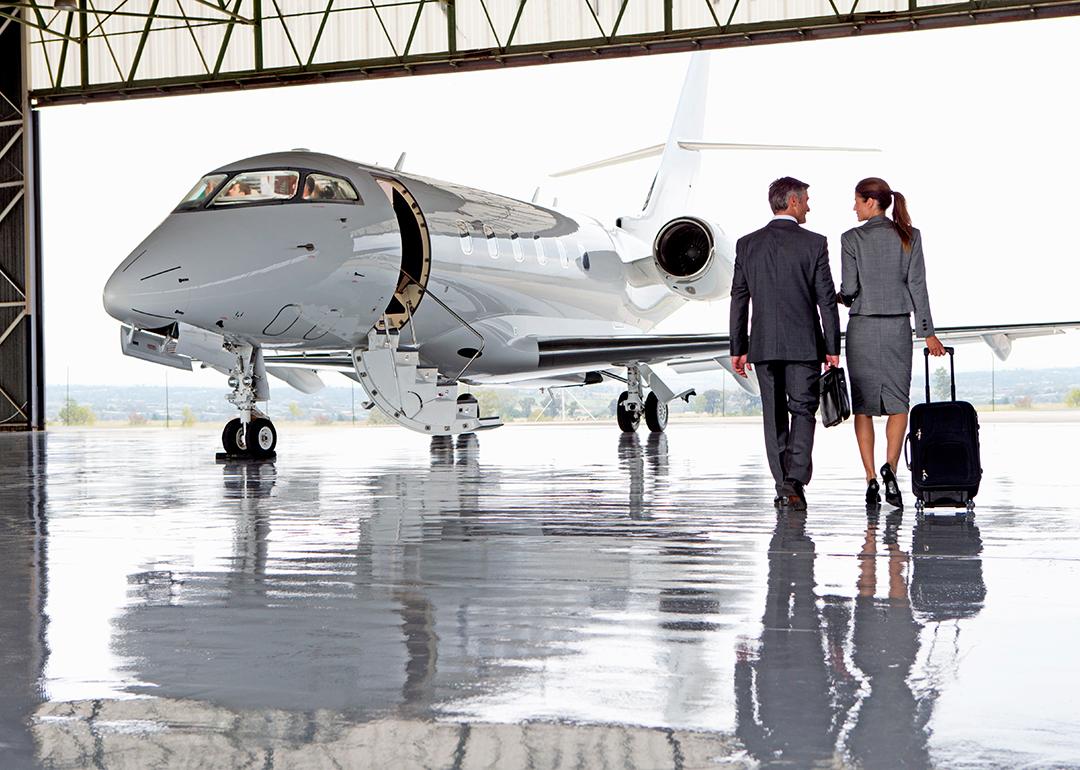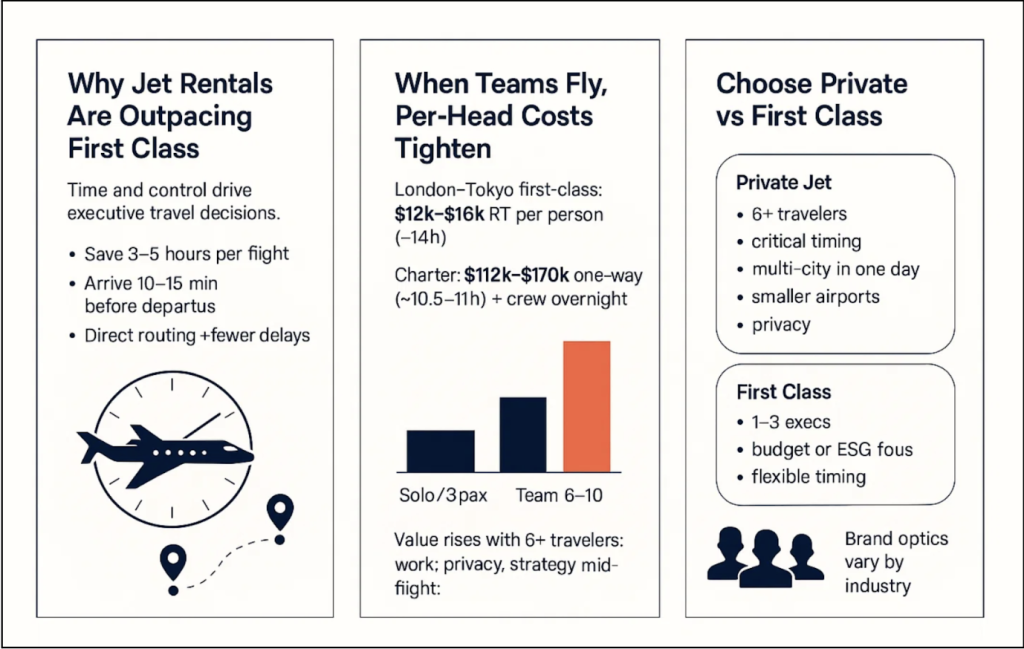
Jet rentals vs. first-class tickets: When each makes sense for corporate travel
Jet rentals vs. first-class tickets: When each makes sense for corporate travel
The private jets charter market is forecasted to reach $29.38 billion in 2025 and $11.9 billion by 2033. Its typical customers are business executives, wealthy individuals, and group travelers who can afford it.
While the post-pandemic world has seen a significant rebound in the volume of business travel, with firms like McKinsey & Company noting that companies are reinvesting in face-to-face engagement, the nature of that travel has changed. As businesses simultaneously tighten their belts, that renewed demand is shifting from the ultra-premium first-class cabin to the more cost-effective business class. This strategic shift has brought a unique opening for private charter jets to fill a needed void.
Looking strictly at the data, it’s safe to say that private charter is starting to look more and more attractive for businesses that must factor travel into their expenses. Jettly highlights some of the reasons behind this shift.
Jet Rentals are Soaring and Here’s Why
In business, time is money, and a high-paid executive spending several hours navigating commercial travel may not be the most efficient use of their time.
First class in this scenario is becoming less of an option because you need to cut down on wasted time.
Time constraints, the number of people who travel, and the urgency of business are some of the primary factors driving the rise in jet rentals.
Flexibility and Scheduling
Flying first class with an airline is a luxurious experience that many executives enjoy, but it also comes with less control over the schedule, layovers, or destination. In a chartered flight, you can set the time of departure and the route, and fly directly to closer or less congested airports.
Private jet travellers save time due to:
- Shorter arrival times (10-15 minutes before departure vs. 2-3 hours depending on if you’re flight is domestic or foreign).
- More direct routes.
- Fewer delays.
- Due to on-demand charter services or fractional ownership, companies can choose the departure times and routes if there are delays or weather issues.
Because the charter can depart or land at smaller airports, businesses can plan trips that include multiple locations in one day. This reduces the need for overnight stays and keeps costs down.
Cost per Person
Believe it or not, chartering a private jet can be surprisingly cost-effective compared to commercial travel—but only when the conditions are perfect. It's a matter of strategy, not just raw numbers.
For a single executive or a very small team, the math is simple: Flying first-class on a commercial airline is almost always the more economical choice. There are other benefits to taking a private jet, but the cost wouldn’t be one of them in this situation. The cost of chartering an entire state-of-the-art aircraft for one or two people is a significant investment that commercial fares, even at the premium level, simply cannot match.
So, where does the math change? With scale and complexity.
Imagine you need to send a full delegation, consisting of 10 senior executives and their specialized equipment, to an international summit. Suddenly, the equation shifts. You're no longer comparing one charter fee to one commercial ticket. You're comparing it to the eye-watering cost of 10 first-class seats, excess baggage fees for sensitive equipment, and the massive logistical headache of coordinating a dozen separate bookings.
That's where the private charter shines. It consolidates all those variables into one streamlined, predictable cost. But the real return on investment isn't just about the money. During that uninterrupted flight, the aircraft becomes a secure, flying boardroom.
Your team can strategize, rehearse presentations, and hold confidential meetings. They arrive not just at the destination, but as a cohesive unit—rested, aligned, and ready to perform at their peak from the moment the wheels touch the ground. You're not just buying a flight; you're buying a competitive advantage.
Brand Reputation and First Impressions
The world of business is all about the image you manage to project. And nowadays, flying first class is no longer as much of an image gain as it once was because of delays and all the hassle built into the commercial flying experience.
On the other hand, the exclusivity of a private jet can project success and power. But this is only true for certain industries, like luxury items, investment firms, or elite consultancies. Other industries see this way of traveling as wasteful and damaging to the environment, so tread carefully.
Jet Rentals vs. First Class
There’s a time for private aviation and a time for flying commercial. Companies that manage to find the right balance and take a hybrid approach are the ones that have the most to win.
When does it make sense to use one over the other? It depends on your end-goal.
It makes sense to use a private jet when:
- You are flying a bigger team (preferably six or more people).
- The timing is critical (important meetings that can’t suffer a delay).
- You want to hit multiple destinations on the same day.
- The origin/destination is remote or not well served by scheduled airlines.
- Your team needs privacy and space to collaborate during flights (for corporate strategy and sensitive travel).
Choose first class on commercial flights when:
- You’re only flying one to three executives.
- The company is on a budget, or stakeholders want to cut down on travel costs.
- There are no significant time constraints.
- Your company has environmental concerns.
- Your industry considers private aviation wasteful.
Jet rentals vs. first-class tickets: When each makes sense for corporate travel?
Jet rentals are on a growing trend, but, for now at least, they are not yet fully outpacing first-class corporate travel. Many executives value private charters for flexibility, privacy, and access to smaller airports, especially for multi-city trips or groups.
However, first-class remains the more cost-efficient option, especially for solo travelers. The decision often depends on company policies, sustainability concerns, and the nature of the trip.

This story was produced by Jettly and reviewed and distributed by Stacker.



